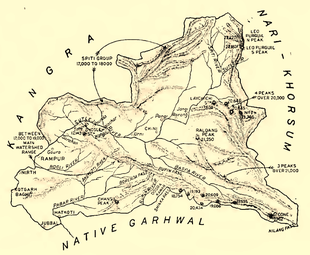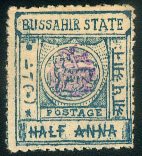Bashahr
| Bashahr | |||||
| 1412-1948 | |||||
|
|||||
| Capital | Sarahan | ||||
| Form of government | Princely State | ||||
| surface | 8907 km² | ||||
| population | 115,000 (1941) | ||||
| founding | 1412 | ||||
| resolution | April 15, 1948 | ||||
| State religion: Hinduism Dynasty: |
|||||
| Map of Bashahr (1911) | |||||
| Postage stamp from Bashahr (1900) | |||||
Bashahr ( Bushahr , Bussahir ) was one of the princely states in the foothills of the Himalayas around Shimla in British India, which then belonged to Punjab . The capital of Bashahr was Sarahan (today: Bushahr Sarahan , in contrast to "Kullu Sarahan" in nearby Outer Saraj , which belongs to Kullu ).
According to history, Pradhuman , a son of the god Krishna , was the founder of the principality. The legend calls the Rana Danbar Singh, a Rajput who came from the Deccan in 1412 . Bashahr was occupied by Nepal in 1803 and liberated by the British in 1815 during the Gurkha War . 1815–1947 the principality was a British protectorate ; the ruler carried the title Raja . In 1898 the British took over administration of the principality, although the Raja nominally continued to rule.
In 1941, Bashahr had an area of 8907 km² and 115,000 inhabitants and on April 15, 1948, as the largest of the principalities, it merged with 30 other small principalities to form the Himachal Pradesh confederation . All principalities were dissolved on November 1, 1956. Raja Virbhadra Singh (1947–1956) was involved in Indian politics from 1962. In 1976 he was Deputy Minister for Tourism and Civil Aviation, 1976/77 Minister of State for Industry and from 1983 several times and also today Chief Minister of Himachal Pradesh .
Bashahr had its own state post with its own postage stamps from 1895–1901.
Historically, the region was an important passage area for caravans on the "Great Hindustan Tibet Road" to Tibet and is now connected to the state capital Shimla by the National Highway 21. The former state territory today forms roughly the district of Rampur Bushahr with Rampur (920 m) in the Sutlej Valley as the administrative seat. The Bhima Kali Temple in Bushahr Sarahan (2160 m), one of the most important temples in the western Himalayas, is traditionally a social center and is still the spiritual center today.
literature
- William Barton: The princes of India . With a Chapter on Nepal. Nisbet, London 1934, (Reprinted edition. Cosmo, New Delhi 1983).
- Bashahr. In: The Imperial Gazetteer of India. Volume 7: Bareilly to Berasiā. New Edition. Clarendon Press, Oxford 1908, pp. 94-95 .
- Bateman, Robert: The postal history of Bussahir. The Press at Ifield, Ifield 1968.
- Andreas Birken : Philatelic Atlas of British India. CD-ROM. Birken, Hamburg 2004.
- Chaman L. Datta: The Raj and the Simla Hill States. Socio-economic Problems, Agrarian Disturbances and Paramountcy. ABS Publications, Jalandhar 1997, ISBN 81-7072-072-9 .
- Joseph E. Schwartzberg (Ed.): A historical atlas of South Asia (= Association for Asian Studies. Reference Series. 2). 2nd impression, with additional material. Oxford University Press, New York NY et al. 1992, ISBN 0-19-506869-6 .

